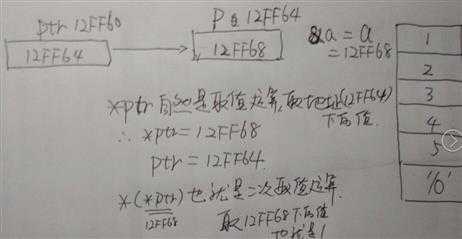标签:
1、指向整型的指针
#include<stdio.h>
int main()
{
int a=5;
int *p;
p=&a;
printf("a=%d &a=%x *p=%d p=%x \n",a,&a,*p,p);
printf("指针变量p的地址=%x\n",&p);
}
| a | &a | *p | p |
| 5 | 12ff7c | 5 | 12ff7c |
| &p | |
| 12ff78 |
2、 指向字符的指针
#include<stdio.h>
int main()
{
char str[5]="abcd";
char *p;
p=str;
printf("str=%s p=%s str=%x *p=%c p=%x \n", str, p, str, *p, p);
printf("指针变量p的地址=%x\n",&p);
}

为什么整型指针p输出的是地址,而字符型指针输出的是字符串呢,字符型指针里存放的不是地址吗?
这里我们来解释一下: 对于指针你用 %s 输出的便是字符串,用%x 便是地址
3、指向整型指针的指针
#include<stdio.h>
int main()
{
int a[6]={1,2,3,4,5};
int *p=a;
int *(*ptr)=&p; // 因为是指针,所以存放的是地址,所以要加 &
printf("a=%x\n",a); // 也就是数组的首地址 12ff68
printf("p=%x\n",p); // p指针变量 存储的值是 数组的首地址 12ff68
printf("&p=%x\n",&p); // p指针变量自身的地址是 12ff64
printf("ptr=%x\n",ptr); // ptr指针变量存储的是 P指针变量的地址 12ff64
printf("&ptr=%x\n",&ptr); // ptr 指针自身的地址12ff60
printf("*ptr=%x\n",*ptr); // *ptr 指的是 12ff68 地址
printf("**ptr=%d\n",**ptr); //**ptr =1
}

标签:
原文地址:http://www.cnblogs.com/shengruxiahua/p/4885057.html